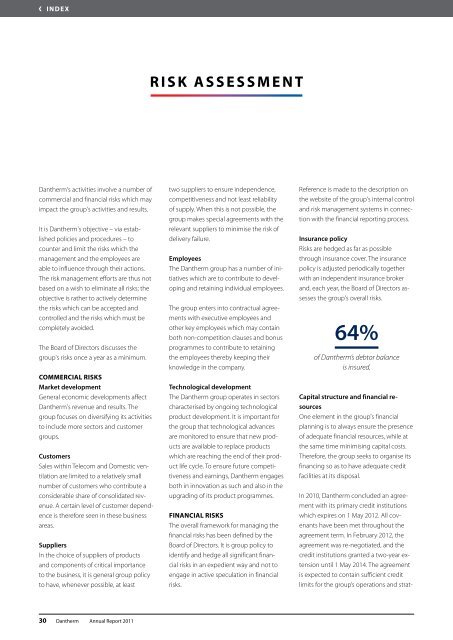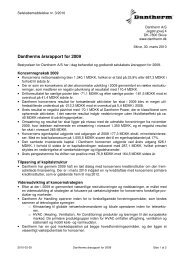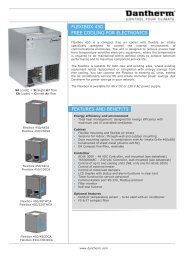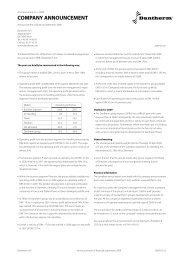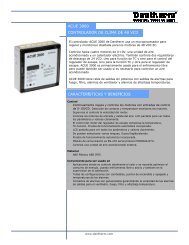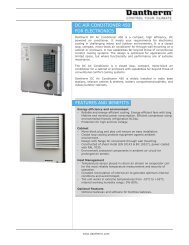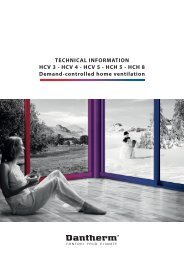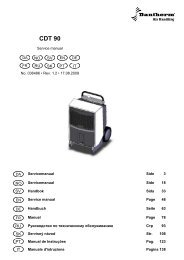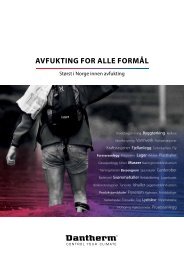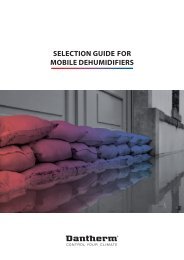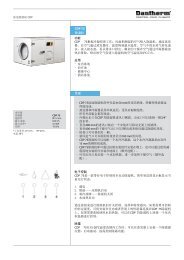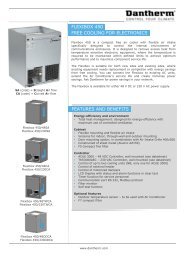Download annual report 2011 here - Dantherm
Download annual report 2011 here - Dantherm
Download annual report 2011 here - Dantherm
Create successful ePaper yourself
Turn your PDF publications into a flip-book with our unique Google optimized e-Paper software.
INDEX INDEXRISK ASSESSMENT<strong>Dantherm</strong>'s activities involve a number ofcommercial and financial risks which mayimpact the group's activities and results.It is <strong>Dantherm</strong>'s objective – via establishedpolicies and procedures – tocounter and limit the risks which themanagement and the employees areable to influence through their actions.The risk management efforts are thus notbased on a wish to eliminate all risks; theobjective is rather to actively determinethe risks which can be accepted andcontrolled and the risks which must becompletely avoided.The Board of Directors discusses thegroup's risks once a year as a minimum.COMMERCIAL RISKSMarket developmentGeneral economic developments affect<strong>Dantherm</strong>'s revenue and results. Thegroup focuses on diversifying its activitiesto include more sectors and customergroups.CustomersSales within Telecom and Domestic ventilationare limited to a relatively smallnumber of customers who contribute aconsiderable share of consolidated revenue.A certain level of customer dependenceis t<strong>here</strong>fore seen in these businessareas.SuppliersIn the choice of suppliers of productsand components of critical importanceto the business, it is general group policyto have, whenever possible, at leasttwo suppliers to ensure independence,competitiveness and not least reliabilityof supply. When this is not possible, thegroup makes special agreements with t<strong>here</strong>levant suppliers to minimise the risk ofdelivery failure.EmployeesThe <strong>Dantherm</strong> group has a number of initiativeswhich are to contribute to developingand retaining individual employees.The group enters into contractual agreementswith executive employees andother key employees which may containboth non-competition clauses and bonusprogrammes to contribute to retainingthe employees t<strong>here</strong>by keeping theirknowledge in the company.Technological developmentThe <strong>Dantherm</strong> group operates in sectorscharacterised by ongoing technologicalproduct development. It is important forthe group that technological advancesare monitored to ensure that new productsare available to replace productswhich are reaching the end of their productlife cycle. To ensure future competitivenessand earnings, <strong>Dantherm</strong> engagesboth in innovation as such and also in theupgrading of its product programmes.FINANCIAL RISKSThe overall framework for managing thefinancial risks has been defined by theBoard of Directors. It is group policy toidentify and hedge all significant financialrisks in an expedient way and not toengage in active speculation in financialrisks.Reference is made to the description onthe website of the group's internal controland risk management systems in connectionwith the financial <strong>report</strong>ing process.Insurance policyRisks are hedged as far as possiblethrough insurance cover. The insurancepolicy is adjusted periodically togetherwith an independent insurance brokerand, each year, the Board of Directors assessesthe group's overall risks.64%of <strong>Dantherm</strong>’s debtor balanceis insured.Capital structure and financial resourcesOne element in the group's financialplanning is to always ensure the presenceof adequate financial resources, while atthe same time minimising capital costs.T<strong>here</strong>fore, the group seeks to organise itsfinancing so as to have adequate creditfacilities at its disposal.In 2010, <strong>Dantherm</strong> concluded an agreementwith its primary credit institutionswhich expires on 1 May 2012. All covenantshave been met throughout theagreement term. In February 2012, theagreement was re-negotiated, and thecredit institutions granted a two-year extensionuntil 1 May 2014. The agreementis expected to contain sufficient creditlimits for the group’s operations and strategydevelopment during the agreementterm.Currency risksIt is group policy to hedge significant currencyrisks arising from foreign currencycontracts w<strong>here</strong> the cash flow can bepredicted with sufficient accuracy. Theneed for hedging is assessed based on anindividual assessment of the contract andthe volatility of the currency.Translation risks relating to the valuationof foreign net investments are generallynot hedged. Capitalisation of the foreignsubsidiaries is targeted in order to reducethe translation risk.At regular intervals, the group's managementconsiders whether loans need to bearranged for balancing large net investmentsw<strong>here</strong> the interest on the currencyin question is lower than the interest onDKK. As a result of the group's internationalactivities, developments in exchangerates between DKK and the various <strong>report</strong>ingcurrencies of the consolidatedcompanies impact the operating profit/loss as measured in DKK. The total netposition in currencies other than DKK andEUR amounted to DKK 27m at the end of<strong>2011</strong> relative to a net liability of DKK 2m atthe end of 2010.Interest rate risksSome of the group's bank financing is inthe form of floating-interest loans. Thisinvolves a risk of changes in interest payments,both in the short and in the longterm. The company regularly assesses theexpediency of entering into agreementsto fully or partly hedge such interest raterisk. An agreement has t<strong>here</strong>fore beenmade which hedges the interest raterisk on the lease on the building in Skive,Denmark.At the end of <strong>2011</strong>, the fixed-rate portionamounted to 51% against 56% at theend of 2010. When hedging the floatinginterest-rate risk, changes in the interestmargin are not hedged. A 1 percentagepoint increase in interest levels will negativelyimpact the group's profit before taxby approx. DKK 1m.Credit risksThe financial situation of the company'sdebtors is assessed on a regular basis, andconsiderable debtor insurance is takenout in the individual companies. Overall,approx. 64% of the debtor balance as at31 December <strong>2011</strong> was insured against54% at the end of 2010.30 <strong>Dantherm</strong> Annual Report <strong>2011</strong> Annual Report <strong>2011</strong> <strong>Dantherm</strong> 31


